
NATIONAL CONCERT HALL
2024 — 2025 SEASON



NATIONAL CONCERT HALL
2024 — 2025 SEASON

GRIEG PIANO CONCERTO
Louis Schwizgebel piano
Friday 4 October 2024
‘A genuine virtuoso, a spirited young genius with real depth’ (FonoForum)
CHOPIN PIANO CONCERTO NO. 2
Yeol Eum Son piano
Friday 13 December 2024
‘Extraordinary, immensely impressive’ (Get the Chance)
Tickets from €15 nch.ie
RACHMANINOV PIANO CONCERTO NO. 2
Lise de la Salle piano
Friday 17 January 2025
‘Wonderfully gifted’ (Gramophone)
BRAHMS PIANO CONCERTO NO. 1
Jonathan Biss piano
Friday 28 March 2025
‘An eloquent interpreter with a powerful technique’ (New York Times)
National Symphony Orchestra
Leonard Slatkin conductor
Hugh Tinney piano
Friday 27 September 2024, 7.30pm
National Concert Hall
Presented by Paul Herriott, RTÉ lyric fm Programme
Daniel Slatkin Voyager 130 World Premiere / 14’
Beethoven Piano Concerto No. 4 / 34’ Brahms Symphony No. 3 / 33’
Broadcast live on RTÉ lyric Live on RTÉ lyric fm
PLEASE NOTE: The NCH does not permit photography or videography during the performance (without prior permission). We kindly ask you to refrain from using any recording equipment for the duration of tonight’s performance.
NCH Board Members
Maura McGrath Chair | James Cavanagh | Cliona Doris
Rebecca Gageby | Hilary Hough | Peter McKenna
Niamh Murray | Michelle O’Sullivan | Don Thornhill
Patron
Michael D. Higgins President of Ireland
Tonight’s programme with the National Symphony Orchestra showcases three very different styles of music. Brahms’s lyrical and unique Third Symphony marks a more intimate outing for the composer and serves as an early example of a work in this form that ends quietly. Listeners will note that I do not pause between the second or third movements but connect them as one arc.
Beethoven’s Fourth Piano Concerto also has a chamber music-like feel to it. The solo part is wonderfully integrated with the orchestra, so at times the instruments engage in dialogue, and at other times they support one another. Just as Brahms ended his symphony softly, here Beethoven makes an equally distinctive statement by having the piano start on its own.
Our programme begins with the world premiere of a work by my son, Daniel. He is active as a composer for film and television, but he created this piece purely for the concert hall. Taking his cue from the Voyager spacecraft, which has been hovering out there for almost 50 years, he connects one of the tracks on the ‘Golden Record’ –the Cavatina from Beethoven’s String Quartet No. 13 (Op. 130) – and weaves a journey that moves us into the farthest reaches of space.
I love my visits with the National Symphony Orchestra and always look forward to our collaborations. This year is especially meaningful as I celebrate my 80th birthday. Thanks to all of you for making it even more special.
Leonard Slatkin
Daniel Slatkin (b.1994)
Voyager 130
When I’m between film and television projects, my wife Bridget often encourages me to write pieces for the concert hall. It stretches my imagination and leads me in directions I may never explore in a visual medium. In the summer of 2022, I took her up on the challenge. When searching for inspiration, I often turn to Beethoven, and as I listened to his string quartets, his 13th (Op. 130) particularly spoke to me. Upon further investigation of the work, I discovered that a recording of the fifth movement is included on the Golden Record, a disk featuring the ‘sounds of Earth’, aboard both Voyager spacecrafts. The spark hit me immediately, and I decided to write a piece that tells the story of Voyager’s journey through space, with the Cavatina providing thematic material.
It begins on the launchpad, with the sounds of calculating computer systems created by electronic synthesizer, the sheer power of the rocket characterized by rumbling low strings and brass, mechanical sounds of tapping metal and wood, an original motif, and a single, staccato oboe, representing the communications system aboard Voyager itself. Anticipation builds, with these systems growing louder and louder, until the rocket finally launches, unleashing a burst of energy and momentum. It’s toward the end of this energetic section that the first reference to the Cavatina occurs – a fragment played like a fanfare in the horns and violas.
The rocket’s fuselages fall away from Voyager, and it is in orbit. While marvelling at the beauty of Earth from above, the first page of the Cavatina is played in its original string quartet form, accompanied by synthesizer sounds and a recording featured on the Golden Record. On it is a series of greetings spoken in dozens of languages, signifying the precious cargo Voyager is carrying – our identity.
The Cavatina and original motif are presented in new arrangements, each one grander than the next, expressing the indescribable sights of this journey. The spacecraft passes Jupiter, Saturn, and Neptune. Suddenly, Voyager reaches the edge of our solar system.
It is no longer traversing the beauty of the universe but rather a cold void. The dizzying feeling of being confronted by this enormity is expressed by the return of the Golden Record greetings, as well as sounds of nature. These are distorted and time-stretched, accompanied by icy, shivering strings, and a somber duet between French and English horns.
The music builds to a climax that bursts with triumph, and out from it emerges peace, with the four principal string players playing a canon featuring new fragments of the Cavatina.
The sounds fade, except for quiet, high-string harmonics, synthesizer effects and the single oboe representing Voyager. As these sounds slowly drift away, we are left with Voyager all alone, floating ever deeper into the great beyond.
Note © Daniel Slatkin
Ludwig van Beethoven (1770-1827)
Piano Concerto No. 4 in G major, Op. 58
I. Allegro moderato
II. Andante con moto
III. Rondo – Vivace
Beethoven wrote his fourth Piano Concerto at the age of 34. He had established a reputation in Vienna as an outstanding pianist, and all five of his piano concertos were written with his own virtuosity and showmanship in mind. When he acquired from London a piano by Broadwood, he told the maker ‘I shall regard that as an altar upon which I shall place the choicest offerings of my mind’.
This concerto is breathtaking in its audacity. Instead of the conventional orchestral opening, it is the piano which commences, quietly, with a dolce chord, a certain footfall which is neither timid nor aggressive. In fact, the opening of this astonishing work establishes the fact that, almost unlike any of Beethoven’s other major works, it requires the most expressive playing throughout, involving subtlety, finesse and superb legato phrasing (the singing of a phrase from its start to its natural conclusion). The orchestra’s response to the piano statement is equally hushed.
The second movement, a sophisticated conversation between soloist and orchestra, again defies convention, since it does not pit the soloist against the orchestra, but engages them in what has been described as a philosophical dialogue. The great pianist Wilhelm Kempff pointed out that ‘on the two pages of full score of this movement there are few notes. Instead there are many rests which sit like birds on the lines of the music, signifying a silence which takes the breath away’. His point – that there are only two pages to what seems like an encyclopedia of emotion – is instructive.
The stern statements by the orchestra are met by extreme tenderness on the part of the piano. It has been suggested that the alternation of insistence on the part of the orchestra and the quiet introspection of the piano resembles Orpheus taming the Furies in Greek mythology. Beethoven’s student Carl Czerny saw in it ‘an antique dramatic and tragic scene’.
Be that as it may, the movement leads directly into a more conventional Rondo – Vivace in which trumpets and drums are heard for the first time. Unlike the first two movements, this is lyrical and witty, as if to lighten our ears after the intensity of what we have been hearing. Beethoven played the work at a private performance in March 1807, when his Coriolan Overture and Fourth Symphony were also premiered. Its first public performance (again with Beethoven as soloist) came much later, in December 1808, at a massive concert in the freezing cold, when the Choral Fantasy and the Fifth and Sixth Symphonies were premiered. Beethoven’s health meant that he was unable to perform the Fifth Piano Concerto himself, in 1811.
Although greeted at the time as ‘the most admirable, singular, artistic and complex Beethoven concerto’, the work lapsed into obscurity until revived by Mendelssohn in 1836, and has never been out of the public ear ever since.
Note by Richard Pine © National Concert Hall
INTERVAL
Johannes Brahms (1833-97)
Symphony No. 3 in F major, Op. 90
I. Allegro con brio
II. Andante
III. Poco allegretto
IV. Allegro – un poco sostenuto
Brahms, despite being probably the greatest symphonist of the later 19th century, was severely self-critical. More than that, he was inhibited by his German musical heritage, especially the predominance of Beethoven, whose nine symphonies were the backbone of all concert-giving in the German-speaking countries. It took Brahms until he was 42 before he could actually publish his first symphony, over which he had agonised for more than 20 years. Up to that point, he had composed his violin concerto and two piano concertos which are almost ‘symphonies with piano’, but hesitated to write a symphony as such. He always heard ‘the footsteps of a giant’ (Beethoven) behind him. Brahms need not have been so self-critical: when he was only a young man, Robert Schumann had identified him as the one composer who would lead the symphony forward.
Although his First and Second symphonies were written in quick succession (in 1876 and 1877), six years would pass before he completed his Third, which he wrote in only four months, mostly while staying in the countryside where he enjoyed the lakes and mountains. In late 1883 he showed it to Dvorˇák, who thought it was superior to the First and Second, principally because Brahms was more confident about where he stood in relation to his musical heritage and was also more sure-footed about how to write for the orchestra alone. Clara Schumann (Robert’s widow, who survived him for many years and became Brahms’s ‘muse’) admired the pastoral qualities of this symphony. ‘All the movements seem to be of one piece’, she said, ‘one beat of the heart, each one a jewel… The mysterious charm of the woods and the forest’.
The main characteristic of symphonies from the later 19th century is that they were freed up from the need to be programmatic or to convey a particular ‘message’. Instead, Brahms had had a playful exchange with the violinist Joseph Joachim (for whom he had written his Violin Concerto): Joachim’s musical ‘motto’ was ‘F-A-E’ (Frei Aber Einsam – free but lonely), while Brahms said his own was composed of the triad ‘F-A flat-F’, which he said stood for Frei Aber Froh (Free but happy).
The motto ‘F-A flat-F’ dominates the opening of this symphony, with its three massive chords, and in fact permeates the whole work as a unifying feature. It becomes a kind of ‘call-and-answer’ in which we hear conversations between different sections of the orchestra.
In the second movement, for example, we hear a conversation between the strings and the winds in what often sounds like a wind serenade. If Brahms were being conventional, we might expect the third movement to be vigorous, but he decides to repeat the introspective, contemplative nature of the first two, with a haunting melody in the cellos.
The finale is equally unconventional, with hesitant murmurings from the strings before the call-and-response idea re-emerges until a huge brass announcement sounds like the end of the world. But characteristically Brahms overcomes these interruptions and brings the music back to a whispering, rather than a declamatory, conclusion.
The symphony is also distinguished by two facts: it’s the shortest of the four symphonies, as if Brahms had the confidence to confine his musical thoughts (‘Free but happy’) within a more compact format; and all four movements end quietly, again suggesting the confidence that he didn’t need major, emphatic conclusions to his work, that it was capable of carrying his ideas more subtly but still positively.
After its premiere, by Hans Richter and the Vienna Philharmonic, Richter pronounced this symphony equal to Beethoven’s symphony, while the critic Eduard Hanslick thought it was the ‘more nearly perfect’ of Brahms’s three symphonies to date. Frank Sinatra would later use the theme from the third movement for his 1950 hit song Take My Love, which gives its singing quality an added cachet.
Note by Richard Pine © National Concert Hall

Leonard Slatkin conductor
Internationally acclaimed conductor Leonard Slatkin is Music Director Laureate of the Detroit Symphony Orchestra (DSO), Directeur Musical Honoraire of the Orchestre National de Lyon (ONL), Conductor Laureate of the St. Louis Symphony Orchestra (SLSO), Principal Guest Conductor of the Orquesta Filarmónica de Gran Canaria, and Artistic Consultant to the Las Vegas Philharmonic. He maintains a rigorous schedule of guest conducting and is active as a composer, author, and educator.
To celebrate his 80th birthday, he is returning to orchestras he led as Music Director, including the DSO, ONL, SLSO, and National Symphony Orchestra (Washington, DC). Additional 2024/2025 highlights include the New York Philharmonic, Nashville Symphony, North Carolina Symphony, Manhattan School of Music Symphony Orchestra, Eastman Philharmonia, National Symphony Orchestra (Ireland), Tokyo Metropolitan Symphony Orchestra, Osaka Philharmonic, Hiroshima Symphony Orchestra, Kristiansand Symfoniorkester, Jerusalem Symphony, and Opera Theatre of St. Louis. Moreover, his composition Schubertiade: An Orchestral Fantasy and arrangement of Scarlatti keyboard sonatas for wind ensemble are receiving world premieres.
Slatkin has received six Grammy awards and 35 nominations. Naxos recently reissued audiophile editions of his Vox recordings with the SLSO featuring the works of Gershwin, Rachmaninov, and Prokofiev. Other Naxos recordings include Slatkin Conducts Slatkin – a compilation of pieces written by generations of his family – as well as works by Saint-Saëns, Ravel, Berlioz, Copland, Borzova, McTee, and Williams.
A recipient of the National Medal of Arts, Slatkin also holds the rank of Chevalier in the French Legion of Honour. He received the Prix Charbonnier from the Federation of Alliances Françaises, League of American Orchestras’ Gold Baton Award, and 2013 ASCAP Deems Taylor Special Recognition Award for his debut book, Conducting Business . A second volume, Leading Tones: Reflections on Music , Musicians, and the Music Industry, was published in 2017, followed by Classical Crossroads: The Path Forward for Music in the 21st Century (2021). His latest books are Eight Symphonic Masterworks of the Twentieth Century (Rowman & Littlefield, 2024) and Eight Symphonic Masterworks of the Nineteenth Century (autumn 2024), comprising essays that supplement the score-study process.
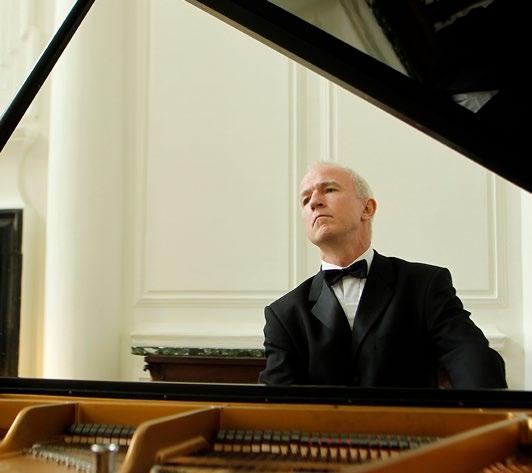
Hugh Tinney first came to international recognition by winning First Prize in two European international competitions, the 1983 Pozzoli in Italy and the 1984 Paloma O’Shea in Spain, and since then he has performed in more than 35 countries throughout Europe, the United States, Latin America and the Far East. A prize in the 1987 Leeds Piano Competition also led to a busy career in Great Britain.
Hugh has made a major contribution to Irish concert life for over 40 years in multiple solo recital series, chamber music series, and frequent concerto appearances. He has played chamber music with many distinguished individuals and groups; he and violinist Catherine Leonard collaborated as a duo for many years.
In 2018, in recognition of his 60th birthday on 28 November, Hugh fulfilled some key celebratory engagements including a 12-stop recital tour of Ireland and Northern Ireland in November, and a performance of Beethoven’s Emperor Concerto with the National Symphony Orchestra to a sold-out National Concert Hall in Dublin.
2019 included performances of Raymond Deane’s cycle Noctuary in Dublin and Madrid. In late 2019 and early 2020 he curated and played in a six-concert chamber series at the National Concert Hall, Beethoven – his Predecessors and Successors .
Since the pandemic, 2021 included chamber music concerts in Limerick, Westport and Dublin Castle. In 2022, Hugh performed Mozart’s ‘Great’ C minor Concerto (K. 491) with the National Symphony Orchestra under their Principal Conductor Jaime Martín in the National Concert Hall, Dublin. The 2022/2023 season included a performance with masterclasses at the Saline Royale Academy in France and concerts at the Killaloe Chamber Music Festival.
In 2024 he performed at Music for Galway’s Cellissimo festival with cellist Alban Gerhardt, and he gave the world première of Anaphora for piano and orchestra by Raymond Deane with the RTÉ Concert Orchestra at the New Music Dublin Festival. More recently, he has played at the Dublin International Chamber Music Festival and at the Westport Festival of Chamber Music.
Get to know the people behind the instruments of the National Symphony Orchestra

second violin, associate principal
When did you join the National Symphony Orchestra? January 2000.
Why did you choose to play your instrument?
In Scotland, children are offered free instrumental lessons at primary school. By chance, I was offered a violin. My dad played the bagpipes and my granny played the accordion so I could have had a totally different musical career path!
Tell us your favourite NSO story/memory so far.
We always have great time on tour. USA 2003 – epic penthouse reception in New York, strolling along West Palm Beach and a day out to Universal Studios. Bucharest 2019 – amazing Parliament Palace tour and divine Romanian wine. And of course, everywhere in Ireland! Always a great welcome from our audiences and delicious pints, post-gig.
Who is your favourite composer and what is your favourite work?
Shostakovich. I loved learning history at secondary school, especially Russian history and documentaries use a lot of his music. The Seventh Symphony is one of my favourites and we will be performing it this season! The Fifth is special, too, as I remember playing it with the National Youth Orchestra of Scotland in my first ever BBC Proms.
What is your greatest achievement – either musical or general?
I had a masterclass with the Vermeer String Quartet at college and they gave me some inspirational compliments about my playing. I really admire their musicianship so it was a real honour for me.
Who is your musical idol?
Prince. I loved him when I was a teenager and saw him once in concert. He wrote all his songs and lyrics, produced, designed all the artwork, played guitar, bass, drums and keyboard, sang falsetto and danced in high heels. Legend!
What do you enjoy doing when you’re not playing with the orchestra?
Gardening – it is so therapeutic, good exercise, vegetables and fruit taste so much better when homegrown and freshly picked. And it makes our environment look prettier and supports bees and wildlife.
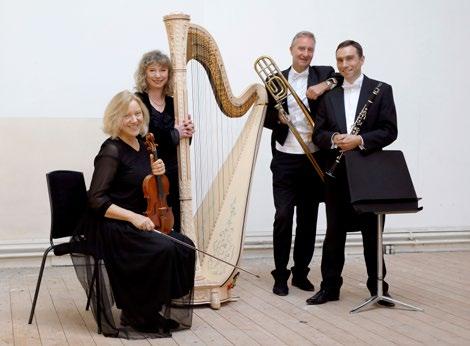

The National Symphony Orchestra has been at the centre of Ireland’s cultural life for over 75 years. Formerly the RTÉ National Symphony Orchestra, it was founded in 1948 as the Raidió Éireann Symphony Orchestra. In 2022, the Orchestra transferred from RTÉ to the remit of the National Concert Hall.
Resident orchestra of the National Concert Hall since its opening in 1981, it is a leading force in Irish musical life through year-long programmes of live music – ranging from symphonic, choral and operatic to music from stage and screen, popular and traditional music, and new commissions – alongside recordings, broadcasts on RTÉ and internationally through the European Broadcasting Union. Schools concerts, family events, initiatives for emerging artists and composers, collaborations with partner promoters and organisations extend the orchestra’s reach.
As a central part of the National Concert Hall’s 2024-2025 Season, the NSO presents more than 55 performances shared between Dublin, Galway, Limerick, Waterford and Cork. They include collaborations with international and Irish artists, ensembles and conductors – including a number of events with the National Concert Hall’s Artists-in-Residence: the renowned American musician and composer Bryce Dessner, the internationally acclaimed Irish mezzo-soprano Tara Erraught, and the dynamic musician and presenter Jessie Grimes. The programme is rich and varied, presenting repertoire from across the centuries to the present day including world and Irish premieres, choral masterpieces, birthday and anniversary celebrations, family concerts and screenings, schools concerts, and professional initiatives for emerging singers and composers. A focus on nature and the environment is a central part of the season’s programming.
Highlights with the Artists-in-Residence are many. They include three Irish premieres by Bryce Dessner: Mari , his Violin Concerto performed by its dedicatee, Pekka Kuusisto, and his Concerto for Two Pianos performed by Katia and Marielle Labèque, for whom it was written. Tara Erraught performs virtuosic works by Mozart, Haydn and Marianne von Martínez, with historical performance specialist Laurence Cummings conducting, and arias by Mozart, Puccini, Bellini, Donizetti and Rossini, with Clelia Cafiero conducting. Tara is also the driving
force behind Celebrating the Voice, a week-long professional development programme for young singers which culminates in an opera gala with the NSO conducted by Anu Tali. Jessie Grimes leads immersive, family-friendly concerts including Our Precious Planet and explorations of iconic works: Beethoven’s Fifth Symphony and Berlioz’s Symphonie fantastique as part of the ASD-friendly Symphony Shorts, as well as Prokofiev’s Peter and the Wolf, featuring new and specially commissioned shadow puppetry, and Britten’s The Young Person’s Guide to the Orchestra.
Other exciting highlights include Dame Sarah Connolly joining conductor Mihhail Gerts for Alma Mahler’s Six Songs; an 80th birthday celebration for conductor Leonard Slatkin which includes the world premiere of his son Daniel’s cosmic journey, Voyager 130 ; Hugh Tinney performing Beethoven’s Fourth Piano Concerto; Speranza Scappucci conducting a Ravel Birthday Celebration; John Storgårds conducting Rachmaninov and Shostakovich; Anja Bihlmaier conducting Mahler’s Ninth Symphony; and Ryan McAdams conducting the First Violin Concerto by Philip Glass with NSO Leader Elaine Clark as soloist; and John Luther Adams’ Pulitzer Prize-winning Become Ocean. Jaime Martín returns to conduct Chopin’s Second Concerto with Yeol Eum Son as the soloist, and former Principal Conductor Gerhard Markson returns for Stanford’s Requiem featuring the National Symphony Chorus and soloists including Máire Flavin and Sharon Carty.
World premieres by Deirdre McKay and Ailís Ní Ríain and, as part of Composer Lab, by Amelia Clarkson, Finola Merivale, Barry O’Halpin, and Yue Song all feature. Irish premieres include a new orchestral setting of Philip Glass’s film score Naqoyqatsi with the Philip Glass Ensemble; Stephen McNeff’s The Celestial Stranger with Gavan Ring as soloist; James MacMillan’s St. John Passion with the National Symphony Chorus and Chamber Choir Ireland; and Ukrainian Victoria Vita Polevá’s Third Symphony.
Additional family events include popular screenings of classic children’s stories by Julia Donaldson and Axel Scheffler – Stick Man and The Snail and the Whale – and Roald Dahl’s Revolting Rhymes . Music in the Classroom returns with Junior Cycle and Leaving Certificate Music Guide events, and Musical Adventures for Primary School children.
1st Violin
Emily Davis Robb
Nicky Sweeney
Sebastian Liebig †
Orla Ní Bhraoin °
Catherine McCarthy
Ting Zhong Deng
David Clark
Anne Harte
Bróna Fitzgerald
Claudie Driesen
Karl Sweeney
Molly O’Shea
Oonagh Keogh
Hannah Choi
2nd Violin
Elizabeth McLaren ‡
Joanne Fleming Campbell °
Steven Crichlow
Rosalind Brown
Paul Fanning
Dara O’Connell
Melanie Cull
Evelyn McGrory
Elena Quinn
Magda Kowalska
Matthew Wylie
Jisun Min
Viola
Emma Sheppard
Francis Harte °
Ruth Bebb
Neil Martin
Cliona O’Riordan
Margarete Clark
Nathan Sherman
Anthony Mulholland
Alison Comerford
Carla Vedres
Cello
Martin Johnson •
Polly Ballard ‡
Violetta-Valerie Muth °
Úna Ní Chanainn
Filip Szkopek
Maria Kolby-Sonstad
Alex Acomb
Matthew Lowe
Double Bass
Milad Daniari
Mark Jenkins ‡
Roger McCann
Waldemar Kozak
Helen Morgan
Jenni Meade
Elena Marigomez
Flute
Catriona Ryan • Ríona Ó Duinnín ‡
Piccolo
Sinéad Farrell †
Oboe
Matthew Manning •
Sylvain Gnemmi ‡
Cor Anglais
Deborah Clifford †
Clarinet
James Gilbert
Seamus Wylie
Bass Clarinet
Fintan Sutton †
Bassoon
Greg Crowley •
Jordy Meulenbroeks
Contra Bassoon
Hilary Sheil †
Horn
Benjamin Hartnell-Booth
Peter Ryan
Bethan Watkeys †
David Atcheler ◊
Kiersten Gustafson
Trumpet
Ben Jarvis
Sam Lewis
Pamela Stainer
Trombone
Jason Sinclair •
Gavin Roche ‡
Bass Trombone
Josiah Walters †
Tuba
Francis Magee •
Timpani
Niels Verbeek
Percussion
Bernard Reilly ◊
Richard O’Donnell
Caitriona Frost
Harp
Andreja Malir •
Piano/Celeste
Fergal Caulfield
• Section Leader
* Section Principal
† Principal
‡ Associate Principal
° String
Sub Principal
◊ Sub Principal 1


Go spreaga an ceol tú.
Bain sult as ceol binn sa Cheoláras Náisiúnta. Is leatsa an Ceol. Is leatsa an Ceoláras Náisiúnta. nch.ie
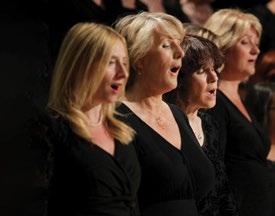



Our ambition is to create spaces where people thrive; modern, sustainable buildings that set the standard for how we work today.
We are proud to be one of Dublin’s largest real estate owners, and with scale, comes the opportunity to shape our city. Our buildings form the cornerstone of neighbourhoods that enhance business life, and are always inclusive, vibrant places for all.
We see every investment, every development, every building as an opportunity to make a positive contribution to local communities and to everyone who lives, works, and socialises there.
NATIONAL CONCERT HALL 2024 — 2025 SEASON
National Concert Hall presents
Philip Glass Ensemble
Philip Glass Glassworks
Philip Glass Excerpts from Satyagraha , Akhnaten and The Photographer
THURSDAY 10 OCTOBER 2024, 8PM
In the first of two concerts dedicated to the music of legend in his lifetime, Philip Glass, the Philip Glass Ensemble showcase his dazzling display of minimalism turned up to the max, in Glassworks , and from three of his mesmeric, ground-breaking operas.
Tickets from €15
Book now on nch.ie
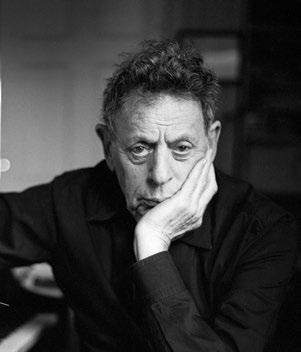
National Symphony Orchestra
Philip Glass Ensemble Michael Riesman conductor
Kate Ellis cello
Philip Glass Naqoyqatsi (Live Screening of film with Irish premiere of new score) for Cello, Orchestra and the Philip Glass Ensemble
Co-commissioned by Los Angeles Philharmonic, Barbican, London and the National Concert Hall.
FRIDAY 11 OCTOBER 2024, 7.30PM
A major event. The Philip Glass Ensemble and close Philip Glass associate Michael Riesman partner with the NSO for the Irish premiere of a compelling new orchestral score from Glass’s stunning soundtrack for Geoffrey Reggio’s 2002 film, Naqoyqatsi (‘life as war’).
NATIONAL CONCERT HALL 2024 — 2025 SEASON
mezzo-soprano
FRIDAY 1 NOVEMBER 2024, 7.30 pm
National Symphony Orchestra
Laurence Cummings conductor & harpsichord
Programme: Haydn, Martínez, Mozart
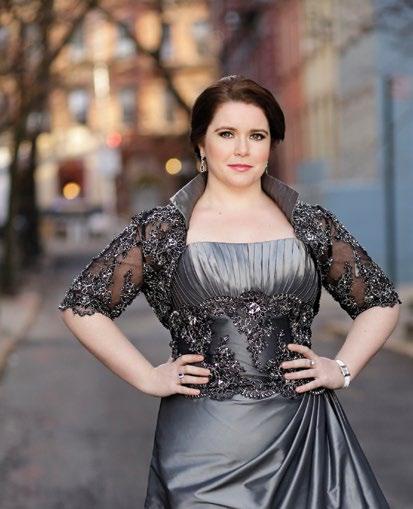
MONDAY 10-FRIDAY 14 FEBRUARY 2025
Celebrating the Voice
Professional Development Programme for Singers & Recital and Orchestra performances
THURSDAY 1 MAY 2025, 7.30 pm
National Symphony Orchestra
Clelia Cafiero conductor
Programme: Mozart, Donizetti, Puccini, Bellini, Rossini
Book now on nch.ie
Tickets from €15
NATIONAL CONCERT HALL
2024 — 2025 SEASON
INTERNATIONAL ORCHESTRAS AND RECITALS
SATURDAY 30
NOVEMBER 2024
7.30PM
Charles Hazlewood conductor Victoria Oruwari soprano

The pioneering ensemble of disabled and non-disabled musicians, with guest soprano Victoria Oruwari, led by Charles Hazlewood perform Górecki’s cathartic and hauntingly beautiful work Symphony of Sorrowful Songs , preceded by Schubert’s Death and the Maiden, a melancholic, iridescent and urgent piece realised for full string orchestra by Mahler.
Pre-concert talk 6.15pm-7pm
Tickets from €15
Discounts and Packages Available nch.ie